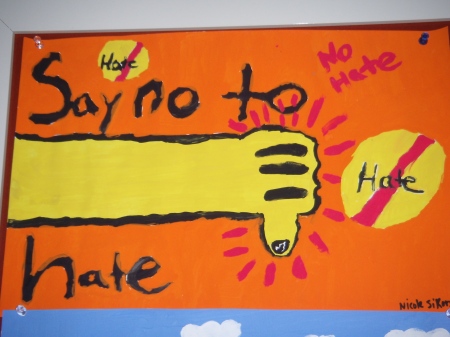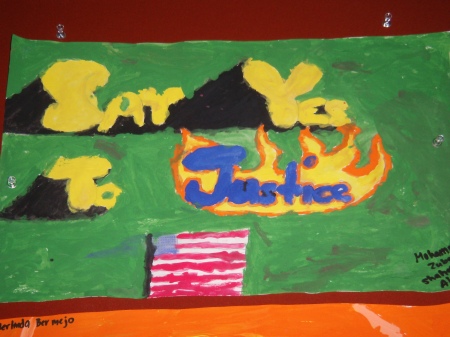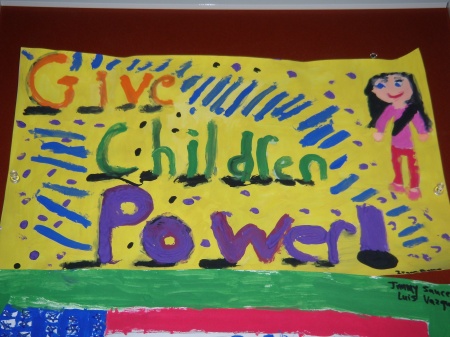









Pictures of our posters!
June 21, 2009Culminating project: Advertising Anti-Hate and Anti-Racism
June 21, 2009During the final days of our unit, the students were asked to list the themes that they felt came out of our study. They listed: injustice, justice, hate, prejudice, discrimination, equality, equity, equal rights, civil rights, freedom, etc…
I provided the students with poster paper and paint and then asked them to choose a partner to come up with a way that they could advertise for one of the above themes.
The posters were beautiful and meaningful. They were displayed in the school auditorium for the 5th grade graduation!
Day by day: How 5th graders began to understand how hate can escalate…
June 21, 2009Day 1: KWL Chart: What is the Holocaust?
Day 2: Read The Butterfly and add to the class KWL Chart
Day 3: Hiding: Why did people need to hide in Europe during World War II? Do we know of other events in history when a group of people had to hide from another? Students offered parallels to the Civil War, slavery in the United States, and Native American History.
Day 4: The students were challenged to make a private list of things that they hate. The were asked to refrain from using names. Students listed people, places, foods, personalities, homework, etc… I then asked the students to count how many entries on their lists were things and then how many were people or groups of people. As the students looked around the room, noticing that many more hands flew to the sky as I asked about people or groups of people that we hate. We did not ever share these lists. They were meant to serve purpose and teach a lesson. We talked about how we all hold prejudices and believe many stereotypes that make us add certain people and groups to our lists. The students were shocked by this discussion. They wanted to talk about why they hate certain people and groups, but I quickly made it clear that the idea behind this unit is not to justify hate; it was to bring hate to the forefront of our class conversation, bringing awareness to ourselves and our community about what hate can lead to if we don’t fight against it.
Day 5: Watch Holocaust video on Brainpop.com and add to KWL chart
Day 6: Understanding what Jewish life was like before, during, and after WWII. Students research life in Europe prior to 1935. Students begin to understand that Jewish businesses were flourishing, freedom of religion allowed Jews to practice without fear, relations among Jews and Germans were strong.
Day 7: Read A Picture Book of Anne Frank. Discuss how life changed for Anne’s family as Hitler rose to power.
Day 8: Watch Anne Frank Video on Brainpop.com. Students write letters to Anne Frank. They asked her questions and told her about times in their lives when they have experienced discrimination.
Day 9: Understanding what life was like in the Ghetto: Read The Cats in Krasinski Square. Discuss the purpose of ghettos, what the Nazis were trying to accomplish by forcing Jews into the ghettos. My students were eager to talk about Ghettos. They defined a ghetto as a place where African American live together for comfort, support, and unity. I asked them to research what the word ghetto means and we then changed our class definition to: A section of a city, where a large number of people that belong to one ethnic or religious group live; usually under political, economic or other hardships. The students were shocked to hear that a ghetto could be more than what they have seen and experienced.
This discussion marked a clear turning point in my classroom. The students were now extremely eager to learn about worldly events and issues. They asked questions such as: If there were ghettos with Jews in Europe during World War II, are there ghettos anywhere else where certain groups are forced to live? How do you end up living in a ghetto? Can you ever get out?
Day 10: Refer back to Hitler Video and discuss Hitler’s Final Solution. How did Hitler plan on getting rid of so many people? Begin discussion of concentration and death camps as well as deportation.
Read: Luba story
Day 11: Understand resistance during the Holocaust and consequences for helping Jews, homosexuals, Gypsies, the disabled, and anyone else being sought after by the Nazis. Refer back to The Butterfly to reference resistance and the underground. Students pointed out similarities between hiding in the Holocaust and hiding slaves in the United States.
Day 12: The Black Holocaust Museum Website http://www.blackholocaustmuseum.org/
At first, the students were shocked that there was a Black Holocaust Museum at all. But with further probing and conversation they began to make parallels between how hate spread in both the Holocaust in Europe and involving African Americans in the U.S.
Day 13: Racism: In my classroom we had much earlier in the year discussed the word Race and how “races” are simply social constructs that have dictated and allowed for Racial discrimination for centuries. On Day 13, we discussed in more depth, what is racism. The students wrote in their journals, describing events and anecdotes from their own lives where they have experiences or witnessed racism or racial bias.
Day 14: Watch DVD Paperclips
After watching the film, we discussed what the paperclip symbolizes and how the Paperclip project changed the small town of Whitwell, TN.
Day 15: My class and I decided that we wanted to do something in order to make sure that something like the holocaust never happens again. The students came up with the idea to write pledges against hate and injustice. At first I modeled a pledge I might write, then the students returned to their desks and wrote their own. They were personal and original.
Day 16: Paper Clip Ceremony: First thing in the morning, the students and I assembled ourselves into a circle in the meeting area. I began by saying that today we would all be reading our pledges aloud, and than excepting a large paperclip to wear on our shirts as a symbol. We would spread awareness around our school by wearing these paperclips everyday for a week. The students were excited! I began, by reading my pledge aloud, then placing my large golden paperclip on my collar. My 29 students each followed. They were clearly enthused and inspired. Even my most difficult students, during our ceremony, remained serious and committed to this community event.
Day 17: A Holocaust Survivor comes to visit our classroom.
On this day, my future grandmother-in-law, who survived WWII Poland, came to speak to my students. Word quickly spread around the school, and 6 out-of-classroom teachers came to join us that afternoon as well. During the survivor’s discussion, the students were engaged, respectful, and intuitive. They asked thoughtful questions and truly showed empathy. Two of my students, having been born in Poland, shared stories of they grandparents experiences during World War II.
After the amazing survivor left for the day, my students wrote her letters of appreciation for sharing her experiences with them. They wrote that she changed the way they think about the world, that they feel fortunate to have spoken to a survivor, and that they understood the Holocaust so much better after her visit.
Multi-Media Used to Teach about the Holocaust
June 20, 2009Books:
The Butterfly by Patricia Polacco
The Cats in Krasinski Square by Karen Hesse
Luba, the Angel at Bergen Belsen by Luba Tryszynska-Frederick
I Never Saw Another Butterfly by Hana Volavkova
Anne Frank: Behind the Diary by Rian Verhoeven, Ruud Van der Rol, Tony Langham, and Plym Peters
DVD:
Paper Clips (2004)
Website:
Brainpop.com: Contains multiple short animated videos that teach about various topics such as WWII, the Holcaust, Hitler, etc…
What is hate?
June 20, 2009To begin our study about standing up against hate, the students and I brainstormed words and situations that we associated with the word HATE. We created a web on large chart paper that still hangs in the back of the room. From this discussion, my students mentioned ideas around gang fights in their communities, violence on the street and bullying in school. We talked about how hate can escalate into violence and how people get involved in violent acts that are fueled with hate.
The next day, the students were broken into groups to define vocabulary around hate and intolerance. The students created their own definitions and then created posters to depict the meanings. These posters to posted around the classroom for reference throughout the entire unit. Vocabulary used: Intolerance, discrimination, prejudice, axis powers, allied powers, genocide, segregation, and holocaust.